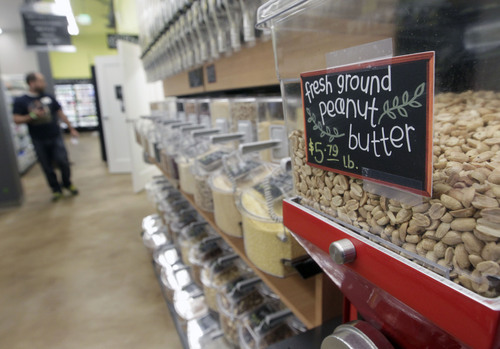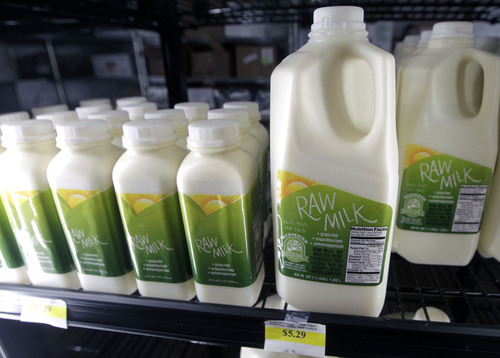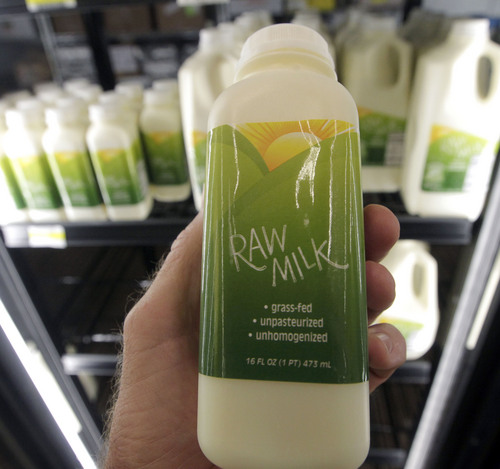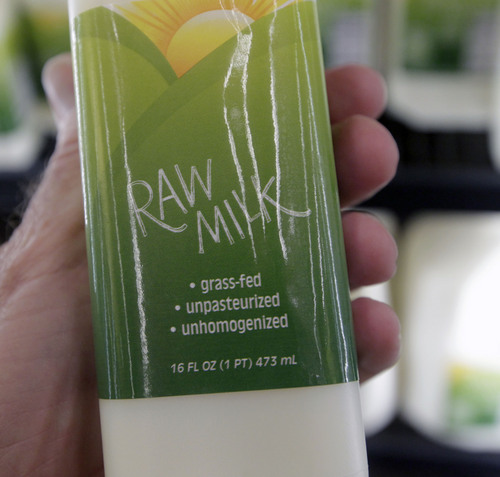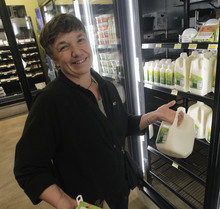This is an archived article that was published on sltrib.com in 2013, and information in the article may be outdated. It is provided only for personal research purposes and may not be reprinted.
The new Real Foods Market in Salt Lake City might resemble other health food stores in the valley, if it weren't for the containers of unpasteurized milk in the dairy case.
"It's our drawing card," said Sue Lytle, general manager of the store, which recently became the first retail outlet in Salt Lake County to sell raw cow's milk.
Located at 2209 S. Highland Drive, and just a few doors south of the Whole Foods health store, the Salt Lake Real Foods is the fourth in the state. The original store opened in Orem in 2005, followed by shops in Heber City in 2008 and St. George in 2011.
Raw milk is much of the reason for the expansion said Brandon Foote, with Utah's Redmond Heritage Farms, which supplies the raw milk, as well as grass-fed beef, eggs and pork. The farm is an offshoot of Redmond Inc., which is known for its sea salt.
"There's definitely a market for it," he said of the raw milk. For many years, customers from the Salt Lake Valley and many cities north have been making the trek to the stores in Orem and Heber to get raw milk. And they've been clamoring for a store closer to home.
"Having that audience propelled us to open a store in Salt Lake City," he said.
—
Milk basics • The product is called "raw" or "real" milk because it hasn't gone through pasteurization, the heating process that lengthens shelf life and kills bacteria responsible for several infectious diseases. Raw milk also has not been homogenized, a sort of straining process that breaks up the cream and prevents it from floating to the top.
There are other differences, too. Raw milk usually comes from cows that are grass fed and not given additional growth hormones to increase production.
Many people who are lactose intolerant say they are better able to digest raw milk because it contains the natural enzymes and beneficial bacterial usually killed during pasteurization.
Others, like Utah native April Brown, simply appreciate the richer taste, as whole milk contains about 4 percent butterfat.
"I buy milk from a dairy farmer near my home in New Zealand," said Brown, who recently returned to the state to visit relatives. "It tastes so much better."
Brown said she drinks raw milk not just for the health benefits but for the ethical way the animals are fed and treated. However, on a recent trip to Real Foods, she noted her disappointment at the company's milk packaging.
"I'd prefer that it was in a glass bottle" that can be returned or recycled, she said. "Maybe that will be next."
Raw milk, however, is more expensive that traditional pasteurized milk. At Real Foods a one-gallon jug costs $7.19, a half-gallon is $5.29; and pints are $2.29.
"I realize not everyone can afford it," said Brown. "But if you can, I think you should."
—
Regulations • Improved food technology, such as stainless steel tanks, milking machines and refrigeration, "has made us better at producing milk in clean and sanitary conditions" said Foote, adding that better testing methods also make it easier to monitor the health of the herd and the quality of the milk before it's sold to consumers.
"Those things are better than they were in the early 1900s," he said, "when producers were transporting raw milk long distances without proper refrigeration.
"We were producing milk not fit to be consumed raw," he added. "Back then pasteurizing saved lives."
Still the "danger" stigma remains and the availability of raw milk for human consumption varies across the nation. Currently, 10 states allow unrestricted sales of raw milk, according to the Weston A. Price Foundation, a clearinghouse for raw milk data. (realmilk.com)
In addition, 15 states allow retail sales as long as the milk producer owns and operates the store. Utah falls in this category but with one caveat, said Richard Clark, with the Utah Department of Agriculture. The producer need only be a majority owner with at least 51 percent ownership in the store.
Clark said that while "there has definitely been more interest in raw milk" in Utah over the last 5 to 8 years, it is still a concern.
"If a consumer is going to buy raw milk, they need to be careful who they buy it from and make sure the producer has a permit," Clark said. "We discourage anyone going to their neighbor with a cow." —
Real Foods Market and Cafe
The makers of Redmond Salt have expanded into the grocery business. The company's four stores sell raw milk, grass-fed beef and eggs produced on its farm in Redmond. It also carries organic produce from Rivendell Farm in Heber City, as well as raw nuts and seeds, sprouted grains, healthy oils and fermented foods.
Salt Lake City • 2209 S. Highland Drive, Salt Lake City; 385-351-2664. Open Monday-Saturday 9 a.m. to 9 p.m.; Sunday 10 a.m. to 3 p.m.
Orem • 420 W. 800 North, Orem; 801-224-0585. Open Monday-Saturday 10 a.m. to 7 p.m.
Heber • 475 W. 910 South, 435-657-3606. Open Monday-Friday, 10 a.m. to 7 p.m.
St. George • 695 S. 100 West; 435-652-4372. Open Monday-Friday, 10 a.m. to 7 p.m.; Saturday 10 a.m. to 6 p.m.
Details • realfoodsmarket.com


